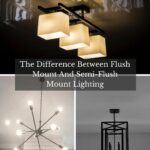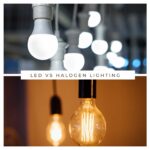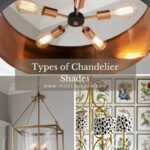Chandeliers are sure to make an impression in any room. When choosing your chandelier, you’ll be faced with many different choices regarding its style, shape and color.
One of these choices will be about shades.
Not all chandeliers need shades– in fact, some will work better without them! However, in some cases, shades may be practically necessary or stylistically pleasing.
Surprisingly, the topic surrounding different types of chandelier shades goes pretty deep. It can be overwhelming when trying to pick out the right style, shape, color and material for your room. We’ve created this guide for exactly that reason!
In this article, we’ll provide a rundown of the different forms these shades can take. This will include:
- An explanation of what chandelier shades are.
- A description of the shapes they can take.
- How these shapes impact style and function.
- A description of the materials they are available in
- The materials that work best in different styles, budgets and rooms.
Let’s get started!
What is a Chandelier Shade?
Before we talk about the specifics of chandelier shade styles, shapes and materials, we should start with the basics.
In simple terms, a lampshade is a structure that sits over the bulb of a light. This serves a few different purposes.
First and foremost, it diffuses the light coming from the bulb and sends it in specific directions.
This is especially important in rooms where you don’t want harsh, intense lighting; you don’t want to spend all your time squinting, after all!
Pretty much every shade will have an opening on the top and bottom. This is how it directs light to where you want it, achieving different purposes depending on the shape of the shade.
When light is directed out of the bottom of the shade, it will directly hit the space below. This will create strong, targeted lighting; great for spaces like a kitchen or office where you need light to see what you’re doing.
When it’s directed out of the top of the shade, light will be bounced off the ceiling. This will create a more even, ambient light effect. This is most useful in calm living areas, like a sitting room or bedroom.
Beyond this functional aspect, there is, of course, the style of the lampshade.
A chandelier will always be a focal point of the room, so you should consider the style of your shade carefully. It should match the existing decor of the room, as well as the feeling you want to evoke.
If your space is traditional and eclectic, you might opt for a colourful, unusually-shaped shade that becomes the center of attention. If your space is clean and modern, you may prefer a more simple, geometric shade in understated colours.
Ultimately, the right shade is the one you like most.
There is no mathematical formula to pick the perfect shade for your house and needs. Besides: Do the exact “rules” of design really matter if you– the person living in the space– like how it looks?
Of course, these rules can help you figure out what looks good to most people, and thus decide your favorite design.
That’s what we’re here for. Moving forward, we’ll explain the different shapes chandelier shades can come in, and what style they normally work best for!
The Different Types of Chandelier Shade Shapes and Styles
If you already have a chandelier that you’re looking to fit with shades, you should make sure that your shades match the existing style of your light and decor. It can be pretty jarring to have a chic, modern shade amidst traditional furnishing!
You should also pay attention to the room the light is in, and whether you want soft, ambient light, or focused light.
Generally, you’ll want softer light in spaces where people are relaxing and chatting. This includes rooms like sitting rooms, bedrooms and dining rooms.
On the other hand, you’ll want more focused lighting in spaces where tasks are performed. This includes kitchens and studies. You want to be able to see what you’re doing when you chop vegetables or read, after all.
1. Empire

This is the “standard” form of lampshade, seen most often on classic style lights.
The shape is tapered from the top, flaring out at the bottom. The intensity of this flare will change between specific models, with a wider flare producing stronger light from the bottom of the shade. This will create a brighter space overall.
Because the light is diffused (but still directed mostly downward), Empire chandelier shades are great for rooms where you want bright light without overwhelming the space. It will be bright enough for reading and seeing other people, while still facilitating a cozy living space.
The Empire style is one of the oldest forms of lampshades, being used for decades across the world. Now, it works perfectly in a traditional, mid-century or classic-style home.
These lights normally come in muted, traditional tones and patterns.
2. Drum

This is another very popular form of lampshade in the modern day.
Instead of drawing from historical inspirations, the Drum chandelier shade provides a clean, modern look for a contemporary household.
A Drum lampshade will have a wide, cylindrical shape with rims of equal size. From the side, it will have a barrel shape.
Because it directs light equally from the top and bottom of the shade, this shape will produce strong, focused light in both directions.
Below the light, you’ll have bright, unfiltered light in a focused area. This is great for dining rooms and studies. Above the shade, the light will bounce off the ceiling to create a soft, ambient light throughout the space.
Depending on the shade material, it will also emit light through the sides, diffused by the shade.
With all of these factors together, your room will have soft, ambient lighting across a wide area, with a strongly focused spotlight directly underneath the light fitting. These lights are an excellent choice for large dining or living rooms!
3. Oval

At first glance, this shade might be mistaken for a Drum shade. If you look closer, you’ll see that it’s narrower in one direction. Looking from above, this will create an oval shape, rather than a perfect circle.
These shades work best in more traditional spaces than their Drum counterparts, suiting a range of historical inspirations.
They are also handy in narrow spaces or with long chandelier designs, as they take up less horizontal space and can be clustered closer together.
The Oval shade can be merged with almost any other type of shade. For instance, you might have an oval empire or oval bell shade. Because of this, they are highly versatile and can suit almost any style depending on the individual shade.
4. Bell

As suggested by the name, these shades have a narrow top that curves out to a flared bottom. This creates an elegant skirt shape, typically suited to traditional or classic decor. Bell chandelier shades work especially well in Victorian-style spaces.
The shape of these shades means that very little light is directed upward, while a large amount is diffused downward into a wide area.
This creates a soft circle of light underneath the shade, with little ambient light reflected from the ceiling.
Because of the width of the lower circle, the focused spotlight becomes so soft it creates the effect of ambient light. This means they work great in living spaces that you want to keep dim and cosy, with a specific area lit up for practicality.
For instance, you might place a Bell shaded light above the sitting area of a living room. This would leave most of the room fairly dim, while the sitting space is lit well enough for comfortable conversation.
5. Square or Rectangular

This fairly recent design fits best in modern or contemporary spaces. They have clean lines and empty facets, complimenting a geometric style of decor.
Some square-based lights may have more interesting shapes if looked at from the side. For instance, they may form Bell, Pyramid or Empire shapes. Others will be completely square or rectangular from every angle.
Because the top and bottom frame of the shade will be the same diameter, the direct equal light up and down.
Thanks to their width, this will produce a strong ambient light reflected from the ceiling, as well as a fairly bright area illumination underneath the light. This makes them a great choice for task lighting.
6. Dome

Sometimes known as a Bowl shade, this lampshade takes the form of an upside-down hemisphere. This exact shape can vary somewhat depending on the lamp.
This wide basin means pretty much all of the light is directed downward, creating a wide area of light for a large space. Depending on the lampshade, it may also diffuse some light upwards through its material, creating a very subtle ambient light.
These shades work best in contemporary, modern or transitional spaces. However, their shape and material can vary widely, possibly suiting more adventurous styles.
7. Circular or Cylinder

These lights are very similar to Drum shades but with taller sides.
Because of the equal size of the frame on each end of the shade, equal light will flow up and downward from the bulb. This will result in plenty of ambient light reflected from the ceiling, as well as a cone of strong light underneath the light.
This cone will get smaller and brighter as the shade gets taller, becoming better for narrow task lighting over a desk or countertop.
Conversely, if the shade is made shorter, the cone will get wider and dimmer. This will be better for living areas like the bedroom, living room or dining room.
These shades can vary widely in design but generally suit modern or contemporary decor.
8. Horn

This type of shade is a lot like a Cylinder shade, but with a very narrow top circle. This creates a “horn”-like effect from the side.
These aren’t often seen on chandeliers, but that doesn’t mean they’re completely unsuited! It really depends on your space, existing style and desired effect. Don’t be afraid to get adventurous once in a while when you’re putting together an interior.
The narrow top of this shade will mean less ambient, reflected light. However, the wide bottom will produce a very bright cone of light.
Effectively, this light will produce the same effect as a narrow Cylinder shade, but with a stronger spotlight effect and less ambient lighting. This is perfect for task lighting in an office or kitchen. It could also be used to highlight a very specific part of the room.
9. Novelty

These shades come in a huge variety of styles and designs, often entirely unique.
Most often, Novelty shades will be adventurous, unusual, and the star of any room they’re put in.
This means they best suit a more adventurous designer. However, if you want a conversation starter to impress your guests, a Novelty shade might be the perfect choice.
Many of these shades are in dramatic shapes and colors, becoming works of art all on their own. They may even take the form of objects, especially natural forms like flowers or fish.
They can come in a huge range of styles. You might think that Novelty shades are only suited to eclectic, traditional shades. On the contrary:There are adventurous, one-of-a-kind shades for every decor style if you know where to look.
The Different Types of Chandelier Shade Materials

When it comes time to choose the material for your chandelier shades, there are a few main options to consider.
Of course, each of these categories have numerous subcategories to consider as well, so make sure to research further into your chosen material.
You should also think about lining. This is the material used on the inside of the lampshade, lining the inner wall. Because it is directly in the path of the light from the bulb, the lining will have a great impact on the final effect of a shade.
Hardback lining will create a tougher, stiffer shade. However, it will also result in less ambient, diffused light coming through the shade.
If reflective, hardback lining can also increase the brightness of the direct light that comes from the top and bottom of the shade by reflecting light toward them.
Soft lining is much less firm and durable. It won’t support the shape of the shade on its own, so will require some sort of hard frame on the inside.
It will usually allow plenty of light to diffuse through the shade, creating strong ambient light. However, it will reflect less light through the openings of the shade, forming a weaker focused light. These will be better for ambient, dim lighting in non-task rooms.
The most important things to consider when thinking about shade material are diffusion, colour, pattern, texture, price, style and practicality.
Let’s break down some of the most popular materials with these things in mind!
1. Glass
Though glass shades are mostly used for pendant lights, they can be seen on some chandeliers as well.
Glass chandelier shades can be completely clear, etched, frosted or stained. Each of these will create a very different effect.
If you want bright, clear light, then clear glass will be the best choice for you. On the other hand, if you want more diffused, gentle light, you might opt for one of the other three types.
Make sure not to discount stained glass! Many people immediately think of Tiffany-style shades when they consider stained glass, but these intricate designs are far from the only option.
Many manufacturers offer much cleaner, streamlined styles of stained glass shades. These can have muted, simple colours and swirling patterns that match a more modern feel. They can help to add interest to a room without overcomplicating a clean, contemporary design.
You should also consider art glass.
This is a special kind of glass that is lighter and more durable than normal. It’s normally a single piece of shaped glass with color, pattern or swirling shapes on its surface. Though expensive, these can be a great way to bring some color and interest to a room.
When using a glass shade, make sure that you choose an appealing bulb, since it will be visible through the shade. It should look good, and match your room’s style.
You should also think about the practicality of glass. It can be difficult to clean, and it’s fairly obvious when it’s dusty or dirty. It can also be fragile, and possibly dangerous when broken. On a chandelier, this shouldn’t be a major concern, however.
2. Fabric

The term “Fabric” covers a wide variety of materials, all of which can serve different purposes and create different effects. We could probably write a whole article on this topic!
For now, we’ll discuss the basics that apply to most fabric chandelier shades.
Fabric is ideal if you want a lot of choices when it comes to color and pattern, since it is available in a huge variety of options.
This makes it a versatile choice for most styles of decor. Choosing darker or lighter fabric will also cause your light to diffuse at different amounts, creating a different ambient lighting effect in your space.
Generally, if you want a dimmer ambient light, choose a darker fabric. Extremely dark lighting may pretty much remove ambient lighting altogether. On the other hand, light fabric will let a lot of light through, creating a bright ambient light in the room.
Fabric can also be styled with features like pleats, which means the fabric is gathered together at the top and bottom of the shade. Features like this can create a more interesting texture on the lampshade.
Some of the more unusual fabric options include things like lace and silk.
Lace is a somewhat old-fashioned style for lampshades that can create incredible patterns on your walls thanks to the light casting through the shade.
Lace shades come in a large variety of patterns, each creating a different effect. It can also be modernised fairly easily. This is mostly done through cleaner, more geometric shapes, and a modern space overall.
Silk is an expensive choice for a lampshade, but has an unmatched shimmer in certain light. It will filter the light, adding colour to your ambient lighting if certain shades of silk are chosen. However, it can be difficult to clean and expensive if damaged.
3. Metal
This is an unusual choice for chandelier shades, but certainly not unheard of. Most often, metal chandelier shades will be seen in industrial, rustic or highly modern designs. Of course, it really depends on your personal style and the specific model of the shade.
Metal shades are normally round or dome-shaped in order to reflect the light out of the openings of the shade.
Because no light will diffuse through the shade, the light will be entirely focused in a cone beneath the light fitting. This will create no ambient light, but a lot of bright illumination below the shade.
Due to this, metal shades are normally best above a kitchen counter or desk.
4. Crystal

This is an expensive option when it comes to chandelier shades, but is unmatched in its shimmering beauty.
These shades are created by fastening together individual prisms of crystal. These then encase the light, refracting it in many directions to create a shimmering, magical effect.
They pair great with chandeliers that already have crystal on them.
Crystal chandelier shades work best in elegant, traditional interiors with a focus on historical, regal decor. They will probably feel out of place in a room that has no gold or marble, but would work incredibly in a grand entrance hall of a regal palace.
5. Tiffany
This antique style was created by Louis Tiffany in the Art Nouveau aesthetic.
They are expensive and eccentric, suited to a detailed, eclectic style. If clean and understated is what you want, I’d skip this section.
However, if you want a centerpiece for your room that has an undeniable personality, a Tiffany-style lampshade might be perfect!
These shades feature metal or soldered frames, normally made out of copper. These outline hundreds of pieces of stained glass.
Tiffany chandelier shades are detailed and intricate, often depicting naturalistic scenes of flowers, animals and landscapes. They have incredibly tiny features that create a complex final work of art.
To match this incredible surface detail, these shades are often in unusual shapes. Some are even sculpted to look like an animal or plant, completely breaking established rules of lampshade designs to create something truly unique and fascinating.
Because the glass is encased in metal framing, these shades are normally pretty sturdy. However, it will hurt if they do get damaged! Tiffany-style lamp shades are fairly expensive, especially as many of them are one of a kind.
Due to these features, these shades often become family treasures, passed through generations.
If you want Tiffany shades, you may need to start hunting through auctions, flea markets, antique shops and online stores. They can be tricky to track down, especially if you have a specific style or design in mind.
Alternatively, you could contact an artist or designer to create one especially for you. This would be more expensive, but also provides an extremely high level of control over the final product.
Tiffany-style shades are timeless, offering a class, artistic look that matches a similarly artsy owner.
6. Linen

Linen refers to a sturdy fabric made out of flax fibers. These are woven together to create a strong, thick material often seen on lampshades.
The natural fibers of Linen create an earthy, organic feeling in the space. This makes them a great fit for beach houses, cabins or naturalistic-style interiors.
With strong textures, they tend to cast patterns on the walls when light shines through and further emphasizes a rustic feel.
Although most Linen chandelier shades will come in more natural, muted tones, the fibers do hold dye fairly well. You can find a variety of Linen shades in more interesting, bright tones if you wish.
In a similar vein, Rattan and Burlap are also great choices for a natural, rustic tone.
Both of them are made from sturdy, natural fibers. Their strong texture will create patterns in the light, and diffuse it nicely to create a cozy space.
You should keep safety in mind when using these materials.
Natural fibres can be dangerous when used as shades over halogen or bright incandescent bulbs. This is because these materials can easily catch on fire when exposed to high heat, as is often produced by these bulbs.
If you want to use one of these materials as shades for your chandelier, it’s recommended that you pick up an LED bulb. LEDs produce much less heat and are safe to use.
7. Paper
This is an affordable option when considering shades for your chandelier.
The effect produced by a paper shade is fairly similar to a plain fabric shade. It will create diffused light, tinted by the color of your shade. This works very well for ambient lighting in large spaces.
Paper is available in a wide range of materials, colors and textures depending on your needs and desired style. You’re sure to find something you like in this material if you look hard enough!
However, paper is a lot more fragile than fabric. If not handled carefully, it’s likely to rip.
If you’re concerned about the price of some of our other options, paper is a great alternative for chandelier shades of pretty much any style and colour.
The Bottom Line
In the end, what really matters in your chandelier’s style is whether you love how it looks.
Don’t worry too much about following all the “rules” of design when choosing features for your home; instead, think of them more as guidelines. The best chandelier is the one you like best!
We hope this article helped you untangle the surprisingly complex topic of chandelier shades. Good luck, we hope you find the perfect shades for your home!







